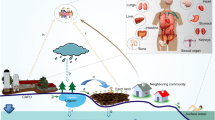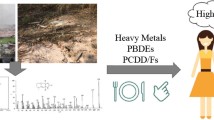Abstract
The open-air storage and disposal of livestock waste from family-operated livestock farms can be a potential health threat to rural residents. In this study, the occurrence and seasonal distribution of 8 potentially toxic elements, 24 antibiotics, and 4 estrogens were investigated in 44 waste samples from 11 rural farms in North China. The results showed that these micropollutants were ubiquitous in livestock waste, with concentration ranges of 238.9–4555 mg/kg for potentially toxic elements, not detected (ND) to 286,672 μg/kg for antibiotics and ND to 229.5 μg/kg for estrogens. The pollutants in animal wastes showed seasonal variation. Since these wastes are directly applicable to nearby farmland without treatment, the risks those wastes pose to farmland soils were also evaluated. Risk assessment results showed that Zn, Cd, Hg, FF and DC in swine manures were at high risk, while total estrogens in chicken and dairy cattle manures were at high risk. The results will provide important data for the regulation of animal wastes produced by small-scale livestock farms in rural areas of China.







Similar content being viewed by others
Data availability
The authors declare that the data supporting the findings of this study are available within the paper and its Supplementary Information files. Should any raw data files be needed in another format they are available from the corresponding author upon reasonable request.
References
Al-saiady MY, Al-shaikh MA, Al-mufarrej SI, Al-Showeimi TA, Mogawer HH, Dirrar A (2004) Effect of chelated chromium supplementation on lactation performance and blood parameters of Holstein cows under heat stress. Anim Feed Sci Technol 117(3–4):223–233
Amarakoon I, Farenhorst A, Rose K, Claeys A, Ascef B (2016) 17 β-estradiol mineralization in human waste products and soil in the presence and the absence of antimicrobials. J Environ Sci Health B 51:655–660
Bagath M, Krishnan G, Devaraj C, Rasgamol VP, Pragna P, Lees AM, Sejian V (2019) The impact of heat stress on the immune system in dairy cattle: A review. Res Vet Sci 126:94–102
Berg J, Thorsen MK, Holm PE, Jensen J, Nybroe O, Brandt KK (2010) Cu exposure under field conditions coselects for antibiotic resistance as determined by a novel cultivation-independent bacterial community tolerance assay. Environ Sci Technol 44:8714–8728
Bolan NS, Adriano DC, Mahimairaja S (2004) Distribution and bioavailability of trace elements in livestock and poultry manure by-products. Crit Rev Environ Sci Technol 34:291–338
Bolan NS, Szogi AA, Chuasavathi T, Seshadri B, Rothrock MJJR, Panneerselvam P (2010) Uses and management of poultry litter. World’s Poult Sci J 66:673–698
Carballo M, Aguayo S, González M, Esperon F, Torre ADL (2016) Environmental assessment of tetracycline’s residues detected in pig slurry and poultry manure. J Environ Prot 7(1):82–92
Chen RH, Zhang QR, Chen HY, Yue WF, Teng YG (2021) Source apportionment of heavy metals in sediments and soils in an interconnected river-soil system based on a composite fingerprint screening approach. J Hazard Mater 411:125125
Dalby FR, Svane S, Sigurdarson JJ, Sorensen MK, Hansen MJ, Karring H, Feilberg A (2020) Synergistic Tannic Acid-Fluoride Inhibition of Ammonia Emissions and Simultaneous Reduction of Methane and Odor Emissions from Livestock Waste. Environ Sci Technol 24(12):7639–7650
Dyar OJ, Zhang TY, Peng Y, Sun ML, Sun CY, Yin J, Ding LL, Sun CT, Wang Y, Sun Q, Greko C, Lundborg CS (2020) Knowledge, attitudes and practices relating to antibiotic use and antibiotic resistance among backyard pig farmers in rural Shandong province, China. Prev Vet Med 175:104858
European Commission (EC) (2003) Technical guidance document in support of commission directive 93/67/EEC on risk assessment for new notified substances, commission regulation (EC) No 1488/94 on risk assessment for existing substances. Directive 98/8/EC of the European Parliament and of the Council Concerning the Placing of Biocidal Products on the Market. Part II. Office for Official Publications of the European Communities, Luxembourg
Fang JJ, Li Q, Liu C, ** ZJ, Liang YM, Huang BH, Lu XX, Peng WJ (2018) Carbon metabolism characteristics of the Karst soil microbial community for Pb-Zn mine tailings. Huan **g Ke Xue 39(5):2420–2430
Guo X, Stedtfeld RD, Hedman H, Eisenberg JNS, Trueba G, Yin DQ, Tiedje JM, Zhang LX (2018) Antibiotic Resistome Associated with Small-Scale Poultry Production in Rural Ecuador. Environ Sci Technol 52(15):8165–8172
Hanselman TA, Graetz DA, Wilkie AC (2003) Manure-borne estrogens as potential environmental contaminants: A review. Environ Sci Technol 37(24):5471–5478
Hashemi M (2018) Heavy metal concentrations in bovine tissues (muscle, liver and kidney) and their relationship with heavy metal contents in consumed feed. Ecotoxicol Environ Saf 154:263–267
Hill D, Morra MJ, Stalder T, Jechalke S, Top E, Pollard AT, Popova I (2021) Dairy manure as a potential source of crop nutrients and environmental contaminants. J Environ Sci 100:117–130
Khan B, Lee LS (2012) Estrogens and synthetic androgens in manure slurry from trenbolone acetate/estradiol implanted cattle and in waste-receiving lagoons used for irrigation. Chemosphere 89(11):1443–1449
Jobling S, Casey D, Rodgers-Gray T, Oehlmann J, Schulte-Oehlmann U, Pawlowshi S, Baunbeck T, Turner AP, Tyler CR (2003) Comparative responses of molluscs and fish to environmental estrogens and an estrogenic effluent. Aquat Toxicol 65(2):205–220
Li C, Li Y, Li XY, Ma XP, Ru SH, Qiu TL, Lu AX (2021) Veterinary antibiotics and estrogen hormones in manures from concentrated animal feedlots and their potential ecological risks. Environ Res 198:110463
Li C, Chen JY, Wang JH, Ma ZH, Han P, Luan YX, Lu AX (2015) Occurrence of antibiotics in soils and manures from greenhouse vegetable production bases of Bei**g, China and an associated risk assessment. Sci Total Environ 521:101–107
Li N, Chen JG, Liu C, Yang JX, Zhu CX, L HN (2022) Cu and Zn exert a greater influence on antibiotic resistance and its transfer than doxycycline in agricultural soils. J Hazard Mater 423:127042
Li N, Li HN, Su GF, Chen JG (2022b) Heavy metal distribution profiles in soil and groundwater near pig farms in China. Chemosphere 294:133721
Liu WR, Zeng D, She L, Su WX, He DC, Wu GY, Ma XR, Jiang S, Jiang CH, Ying GG (2020) Comparisons of pollution characteristics, emission situations, and mass loads for heavy metals in the manures of different livestock and poultry in China. Sci Total Environ 734:139023
Luo L, Ma YB, Zhang SZ, Wei DP, Zhu YG (2009) An inventory of trace element inputs to agricultural soils in China. J Environ Manage 90(8):2524–2530
Ma C (2019) Discussion on the prevention and control measures of pollution in non-scale livestock and poultry breeding. Environ Prot Circ Econ 39(06):83–85,90
McBride MB, Mathur RR, Baker LL (2011) Chemical extractability of lead in field-contaminated soils: implications for estimating total lead. Commun Soil Sci Plant Anal 42(13):1581–1593
Pereira Leal Leal RM, Figueira RF, Tornisielo VL, Regitano JB (2012) Occurrence and sorption of fluoroquinolones in poultry litters and soils from sao Paulo State, Brazil. Sci Total Environ 432:344–349
Pu C, Liu H, Ding GC, Sun Y, Yu XL, Chen JH, Ren JY, Gong XY (2018) Impact of direct application of biogas slurry and residue in fields: In situ analysis of antibiotic resistance genes from pig manure to fields. J Hazard Mater 344:441–449
Sun YM, Guo YJ, Shi MM, Qiu TL, Gao M, Tian SL, Wang XM (2021) Effect of antibiotic type and vegetable species on antibiotic accumulation in soil-vegetable system, soil microbiota, and resistance genes. Chemosphere 263:128099
Wang F, Qiu L, Shen YJ, Ge YH, Hou YQ (2015) Investigation and analysis of heavy metal contents from livestock feed and manure in North China. Trans Chin Soc Agric Eng 31(5):261–267
Wang H, Chu YX, Fang CR (2017) Occurrence of Veterinary Antibiotics in Swine Manure from Large-scale Feedlots in Zhejiang Province, China. Bull Environ Contam Toxicol 98(4):472–477
Watenabe M, Guruge KS, Uegaki R, Kure K, Yamane I, Kobayashi S, Akiba M (2023) Occurrence and the potential ecological risk of veterinary antimicrobials in swine farm wastewaters in Japan: Seasonal changes, relation to purchased quantity and after termination of oxytetracycline usage. Environ Int 173:107812
Xu P, Zhou X, XU DF, **ang YB, Ling WT, Chen MD (2018) Contamination and risk assessment of estrogens in livestock manure: a case study in Jiangsu Province, China. Int J Environ Res Public Health 15(1):125
Yang X, Li Q, Tang Z, Zhang WW, Yu GH, Shen QR, Zhao FJ (2017) Heavy metal concentrations and arsenic speciation in animal manure composts in China. Waste Manage 64:333–339
Ye L, Cook NJ, Liu TG, Ciobanu CL, Yang YL (2012) The Niujiaotang Cd-rich zinc deposit, Duyun, Guizhou province, southwest China: ore genesis and mechanisms of cadmium concentration. Mineral Deposita 47:683–700
Zhang H, Shi JH, Liu XW, Zhan XM, Chen QC (2014a) Occurrence and removal of free estrogens, conjugated estrogens, and bisphenol A in manure treatment facilities in East China. Water Res 58:248–257
Zhang H, Shi JH, Liu XW, Zhan XM, Chen QC (2014b) Occurrence of free estrogens, conjugated estrogens, and bisphenol A in fresh livestock excreta and their removal by composting in North China. Environ Sci Pollut Res 21(16):9939–9947
Zhang LX, Zhu GY, Ge X, Xu G, Guan YT (2018) Novel insights into heavy metal pollution of farmland based on reactive heavy metals (RHMs): Pollution characteristics, predictive models, and quantitative source apportionment. J Hazard Mater 360:32–42
Zhi S, Shen SZ, Zhou J, Ding GY, Zhang KQ (2020) Systematic analysis of occurrence, density and ecological risks of 45 veterinary antibiotics: Focused on family livestock farms in Erhai Lake basin, Yunnan, China. Environ Pollut 267:115539
Funding
This study was funded by the Science and Technology Innovation Project of the Bei**g Academy of Agriculture and Forestry Sciences (grant nos. KJCX20210424, KJCX20230309, and KJCX20230817), and the Youth Science Research Fund of the Bei**g Academy of Agriculture and Forestry Science (QNJJ202116).
Author information
Authors and Affiliations
Contributions
All authors contributed to the study conception and design. Material preparation, data collection and analysis were performed by **nyu Li, Xupu Ma, Tianlei Qiu and **ncheng Fu. The methodology and data curation were performed by Zhihong Ma and Hua **. The first draft and review of the manuscript was written by Yang Li and Cheng Li, and all authors commented on previous versions of the manuscript. All authors read and approved the final manuscript.
Corresponding author
Ethics declarations
Ethical approval
Not applicable.
Consent to participate
Not applicable.
Consent to publish
Not applicable.
Competing interests
The authors declare no competing interests.
Additional information
Responsible Editor: Ester Heath
Publisher's Note
Springer Nature remains neutral with regard to jurisdictional claims in published maps and institutional affiliations.
Supplementary Information
Below is the link to the electronic supplementary material.
Rights and permissions
Springer Nature or its licensor (e.g. a society or other partner) holds exclusive rights to this article under a publishing agreement with the author(s) or other rightsholder(s); author self-archiving of the accepted manuscript version of this article is solely governed by the terms of such publishing agreement and applicable law.
About this article
Cite this article
Li, Y., Li, X., Ma, X. et al. Livestock wastes from family-operated farms are potential important sources of potentially toxic elements, antibiotics, and estrogens in rural areas in North China. Environ Sci Pollut Res 30, 118456–118467 (2023). https://doi.org/10.1007/s11356-023-30663-w
Received:
Accepted:
Published:
Issue Date:
DOI: https://doi.org/10.1007/s11356-023-30663-w




